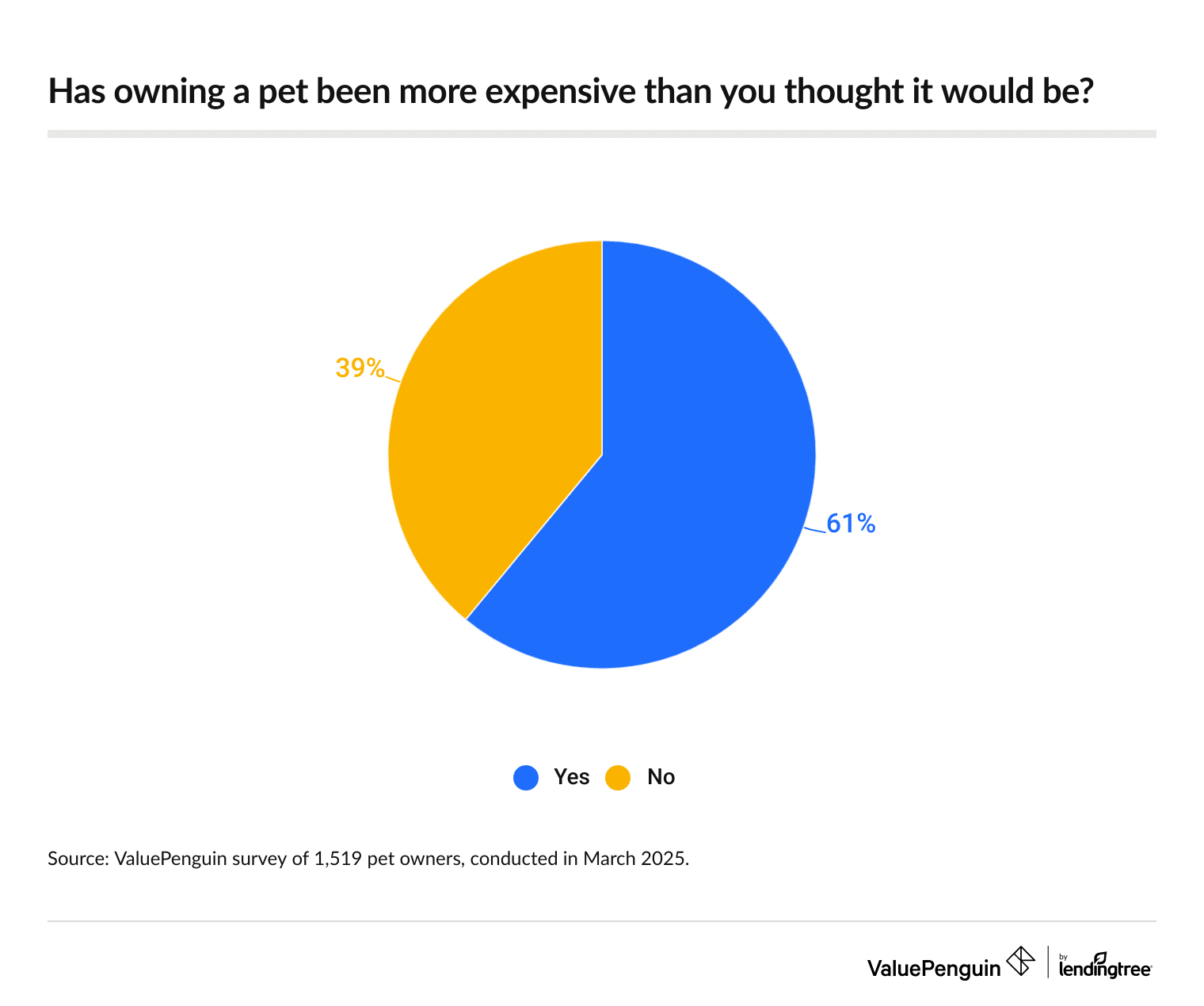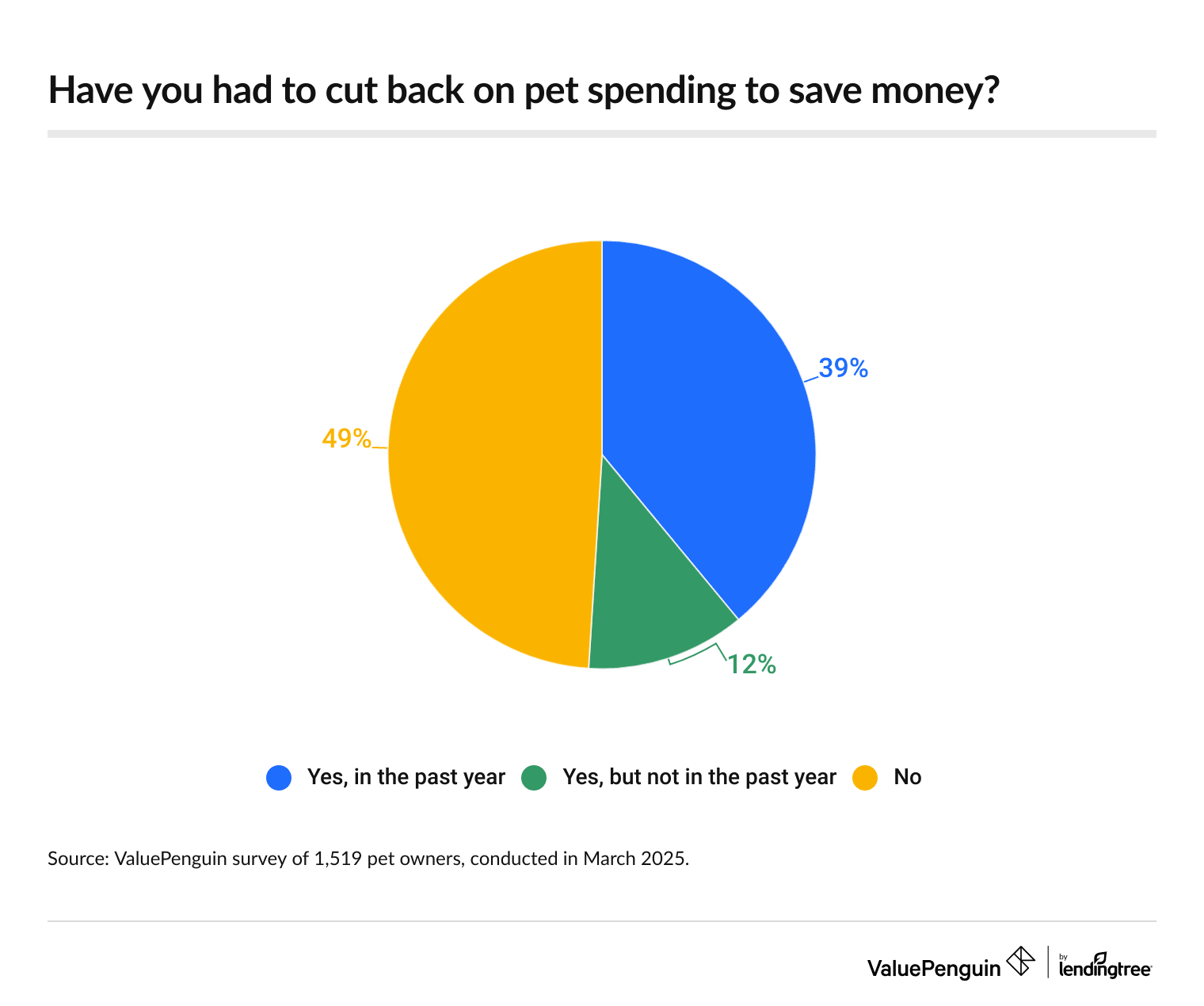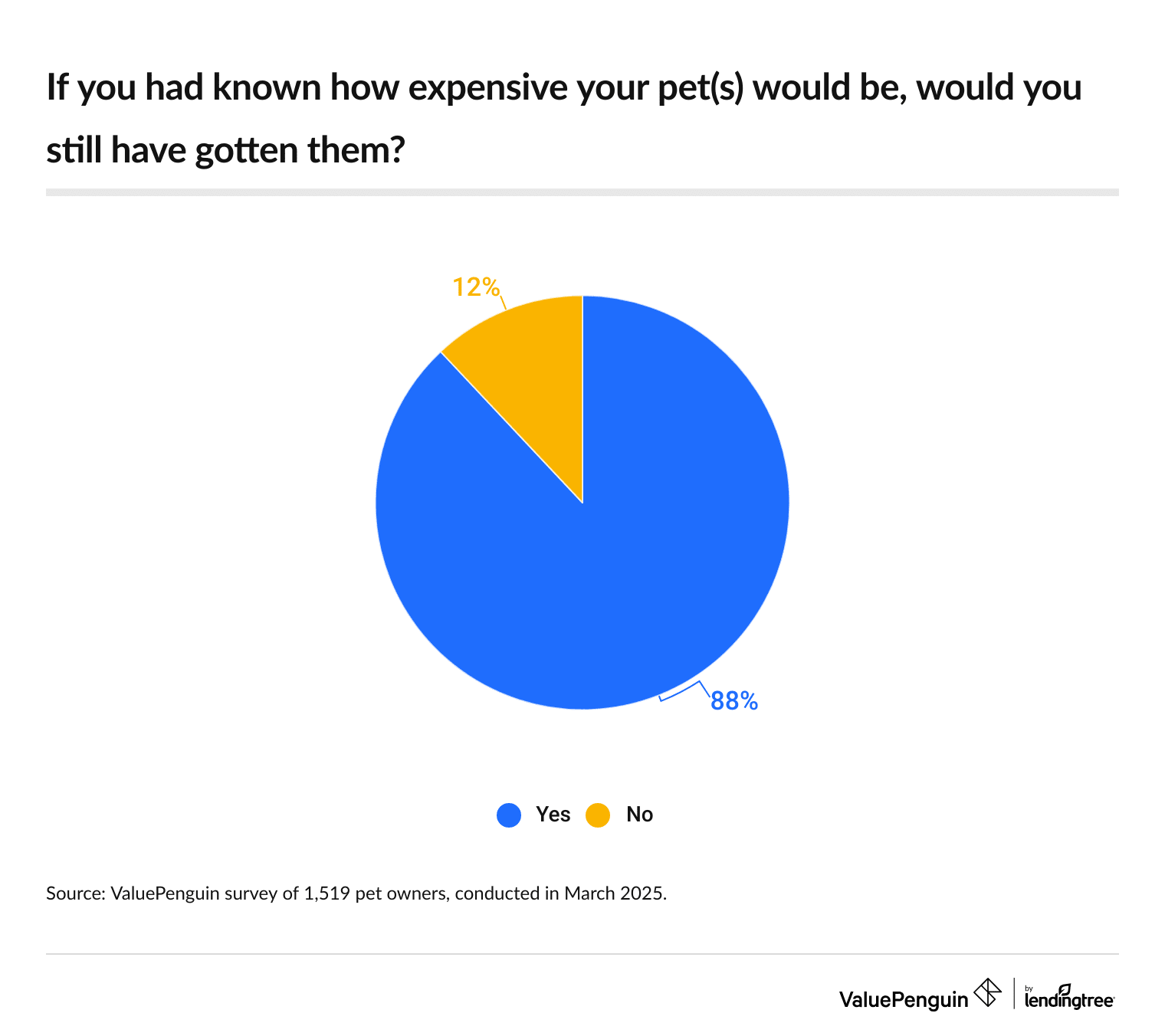Pet Insurance
61% of Pet Owners: Furry Friends More Expensive Than We Thought

They say money can’t buy love, but anyone with a pet knows love can come with a ruff price tag.
According to a ValuePenguin survey of 2,000 U.S. consumers, 61% of pet owners say ownership costs have been more expensive than expected. That’s backed by owners saying they spend an average of $1,750 annually on their pets.
Here’s a closer look.
On this page
Key findings
- The costs of owning a pet surprise many. 61% of pet owners say related costs have been more expensive than expected, but the same percentage (61%) admit to not doing cost research. Overall, owners spend an annual average of $1,750 on their pets.
- Some become more frugal with Fido. 51% of pet owners have cut back on their pet spending — 39% in the past year. However, some pet expenses are unavoidable. 49% of pet owners say they’ve had to take their pet to an emergency vet or treat them for a serious medical issue. Pet owners spent an average of $902 on their priciest unexpected expense.
- Many pets’ lives are priceless to their owners. 73% of owners say they’re willing to go into debt to save their pet’s life, and 29% say they would spend more than $5,000 on their pet’s lifesaving medical care. However, nearly 1 in 2 confess they can’t afford a $1,000 pet emergency. While pet owners are willing to go into debt, 72% don’t have pet insurance.
- For almost all, the rewards outweigh the costs. 88% of pet parents say they still would have gotten their pet despite the high cost of ownership. 80% say they’ve never considered surrendering their pet due to costs, and 55% say they want more pets.
Majority of pet owners say theirs are costly
Between toys, food and surprise vet visits, pet owners’ savings may start to roll over and play dead. Across pet owners, 61% say ownership costs have been more expensive than expected. That percentage rises among pet owners with children younger than 18 (68%) and millennials ages 29 to 44 (67%).

ValuePenguin insurance expert and licensed insurance agent Rob Bhatt says most Americans feel sticker shock over rising costs in many areas of their lives.
"Pet ownership is particularly expensive when you first get your pet," he says. "You need things like food bowls, collars, leashes, safety harnesses and carriers. Young pets also usually need checkups and vaccinations. These costs can add up quickly."
Some of these costs subside as your pet reaches adulthood, Bhatt says. You'll still have to feed your pet and seek routine veterinary care, while most are tempted to spoil them with fun toys and accessories. "This is OK as long as you keep it reasonable," he says. "The emotional bond you can form with a pet is wonderful."
With that, the same percentage of those who say ownership has been more costly than expected (61%) admit to not doing cost research before adopting or buying their pet. Baby boomers ages 61 to 79 (83%) are particularly likely to have been uninformed. Women (67%) are also much more likely to have skipped research than men (54%).
In total, owners spend an average of $1,750 annually on their pets. Perhaps unsurprisingly, six-figure earners ($2,414) spend the most, with parents with kids younger than 18 ($2,334) close behind. Just two other groups spend over $2,000 on average: millennials ($2,083) and those earning $50,000 to $99,999 ($2,012).
It’s not just about the money; it’s about the time commitment, too. In fact, 47% admit that their pet is more work than they expected.
Dogs are most popular pet, while adopting is most popular method
Dogs are America’s favorite pets: Across all Americans, 54% have a dog. That percentage is much higher among parents with kids younger than 18 (67%) and six-figure earners (61%).
Following that, 41% of Americans have a cat. Also, some keep fish (7%), reptiles (3%) or birds (3%).
As far as how they got their pet, adoption was the most common method, with 36% of pet owners adopting from a shelter or animal rescue. Meanwhile, 31% got their pet from someone looking to rehome it and 22% say their pet was a former stray.
Also, 24% of pet owners say they bought their pet from a breeder and 12% say they bought it over social media.
More than half cut back on pet spending
Pets may not be happy about it, but owners are cutting back, with just over half (51%) reducing their pet spending. Of all pet owners, 39% have cut back in the past year.

That being said, though, not all expenses are predictable. In fact, 49% of pet owners have had to take their pets to an emergency vet or treat them for a serious medical issue. Pet owners spent an average of $902 on their most expensive unexpected expense.
That figure hit four digits among six-figure earners ($1,190) and parents with children younger than 18 ($1,009).
"You can take all the precautions in the world to try to keep your pet healthy and safe, but the unpredictable still happens," Bhatt says. "Pet health insurance is one way to manage surprise vet expenses, but it comes with a price."
The most common pet insurance policies are accident and unexpected illness plans, which can protect you from the largest unexpected expenses but don’t usually cover routine checkups, vaccinations, dental cleanings and other preventive care. That can be added with wellness coverage, though that results in higher insurance costs.
Bhatt warns these plans don't cover all of your pet's treatment costs. They usually cover anywhere from 60% to 90% of the bill after you pay your deductible. This can still save you a few hundred dollars or more for major incidents, but you'll feel a loss in your wallet.
Owners would go into debt for their pets’ care
Expenses may be high and emergency vet trips may put a massive dent in owners’ wallets, but many don’t mind the sacrifice. Nearly three-fourths (73%) of owners are willing to go into debt to save their pet’s life.
Meanwhile, 29% say they would spend more than $5,000 on a lifesaving medical procedure or service for their pet.

That would certainly spell debt for many pet owners, particularly as 49% say they can’t afford a $1,000 pet emergency. Owners earning less than $30,000 (75%), those earning $30,000 to $49,999 (59%) and women (59%) are the most likely to say they wouldn’t be able to afford it.
One way owners may be able to avoid vet debt is through pet insurance. However, 72% of owners say they don’t currently have it. For those who do, dog owners pay an average of $53 a month and cat owners pay $32 a month, according to separate ValuePenguin research.
While Bhatt says pet insurance can take some of the unpredictability out of veterinary care for your pet, the amount you could save depends on the coverage you get.
"In a certain sense, pet insurance is like a forced savings account," he says. "Instead of putting money into your bank account, you're paying a pet health insurance company to hold your money until you need it for your veterinary care. That said, an accident or unexpected illness plan can protect you from potentially devastating bills if there’s a severe incident."
Pet owners say high costs are worth it
Pet ownership may come with hefty price tags, but 88% of pet parents say they still would’ve gotten their pet even if they’d known about the costs.

Meanwhile, 80% have never considered surrendering their pet due to costs and 55% say they want more pets eventually.
Considering pet insurance? Top expert tips
If you’re thinking of getting pet insurance for a new or existing pet, Bhatt cautions that some plans are better than others. It's important to review the coverages, rates, deductibles and limits to make sure the benefits are greater than the costs.
"You'll probably get the most use out of a preventive pet health insurance plan when your pet is still a puppy or kitten," he says. "You may not need a preventive health policy as your pet matures, unless they develop a condition that requires frequent care. Pet health insurers usually don't cover treatment for preexisting conditions. However, these may be covered if your pet was young and already insured when diagnosed."
A preventive plan may save you money if you board your pet frequently. Boarding facilities often require more vaccinations than your pet would otherwise need.
"The peace of mind you can get from a pet accident plan may be worth the price," he says. "You can usually lower your rate by choosing a higher deductible and/or less coinsurance, which is the portion of treatment the insurer covers. You'll pay more out of pocket with a higher deductible and/or less coinsurance, but you'll still have protection from the largest expenses."
Methodology
ValuePenguin commissioned QuestionPro to conduct an online survey of 2,000 U.S. consumers ages 18 to 79 from March 4 to 6, 2025. The survey was administered using a nonprobability-based sample, and quotas were used to ensure the sample base represented the overall population. Researchers reviewed all responses for quality control.
We defined generations as the following ages in 2025:
- Generation Z: 18 to 28
- Millennial: 29 to 44
- Generation X: 45 to 60
- Baby boomer: 61 to 79
